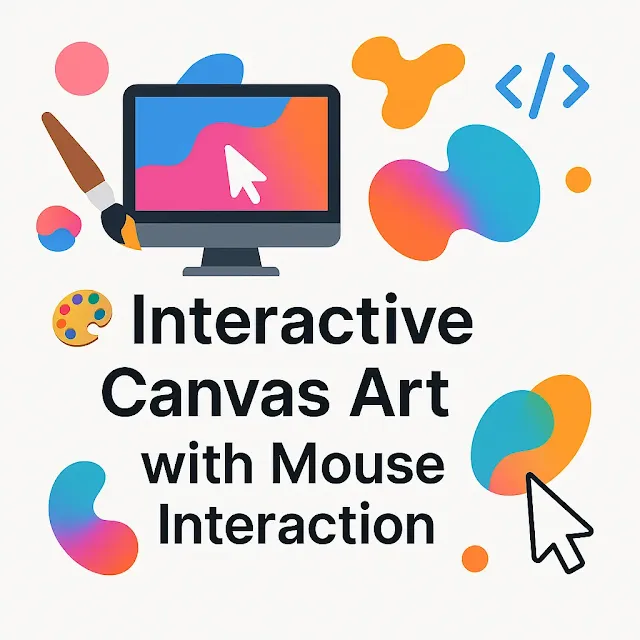🌟 Introduction: What Is Interactive Canvas Art?
Have you ever hovered your mouse over a website element and seen it respond instantly—like shimmering particles or expanding shapes? That’s interactive canvas art in action. It’s a fusion of code and creativity that brings static visuals to life through real-time mouse interaction.
Whether you're an artist, a creative coder, or just curious about merging art and interactivity, this post will walk you through building dynamic canvas visuals using p5.js, a JavaScript library designed for creative coding.
👉 By the end of this tutorial, you’ll understand how to:
- Create an HTML canvas
- Use mouse input to affect visuals
- Build responsive shapes and brushes
- Add fun, artistic interaction to your digital projects
🧠 Exploring the Magic of Mouse Interaction
Before we dive into code, let’s understand the why and how behind mouse interactivity.
What Makes Art Interactive?
Interactive art reacts to the viewer — in our case, through mouse movement, clicks, or scrolls. It creates a feedback loop between the user and the system, making the user part of the art.
The Tech Behind the Magic: Event Listeners
In web-based art, we use event listeners to capture input like mousemove, mousedown, or wheel. These events trigger code that updates the canvas in real time — like changing colors, drawing shapes, or even triggering sound.
🎯 Think of it like: “When the user does X, do Y on the canvas.”
Now let’s start coding!
🖼️ Creating a Basic Interactive Canvas (Using p5.js)
🔧 Step 1: Set Up Your HTML & Script
Let’s load the p5.js library from a CDN so we can use its canvas and mouse features.
🔹 Snippet 1: Basic HTML and p5.js Script Setup
<!DOCTYPE html>
<html>
<head>
<title>Interactive Canvas Art</title>
<script src="https://cdnjs.cloudflare.com/ajax/libs/p5.js/1.4.0/p5.js"></script>
</head>
<body>
</body>
</html>
Explanation:
- We're including the p5.js CDN so we don’t need to install anything.
- There’s no content in the
<body>— p5.js will create the canvas for us using JavaScript.
🎨 Step 2: Create a Canvas and Responsive Background
We’ll create a canvas that fills the window, and the background color will respond to horizontal mouse movement.
🔹 Snippet 2: Canvas and Mouse-Responsive Background
function setup() {
createCanvas(windowWidth, windowHeight);
}
function draw() {
let bgColor = map(mouseX, 0, width, 0, 255);
background(bgColor, 100, 200);
}
Explanation:
setup()runs once to create the canvas.draw()runs 60 times per second, giving us real-time animation.map()translates mouseX (horizontal position) into a value between 0–255, used for background color.
🌈 Result: As you move your mouse side-to-side, the background color shifts dynamically!
🌀 Advanced Interactive Canvas Techniques
Now let’s spice things up with clickable shapes and brush-like trails.
✏️ Step 3: Draw Shapes on Mouse Click
Let’s allow users to click anywhere on the canvas to draw a circle.
🔹 Snippet 3: Add Mouse Click Interaction
function mousePressed() {
fill(random(255), random(255), random(255));
noStroke();
ellipse(mouseX, mouseY, 50, 50);
}
Explanation:
mousePressed()runs whenever the user clicks.- It draws a random-colored circle at the click location using
mouseXandmouseY.
🎨 Step 4: Create a Brush That Follows the Mouse
Next, we’ll build a brush that follows the mouse and leaves a colorful trail.
🔹 Snippet 4: Brush Tool with Mouse Movement
function draw() {
let brushColor = color(random(100, 255), 100, 255, 80);
fill(brushColor);
noStroke();
ellipse(mouseX, mouseY, 20, 20);
}
Explanation:
- Instead of clearing the canvas with
background(), we leave traces of each ellipse. - This creates a paintbrush trail that follows your mouse.
- The alpha value (
80) makes each circle slightly transparent, adding a layered, glowing effect.
💡 Tip: You can add keys like
mouseDragged()for more control!
🔊 Step 5 (Optional): Add Sound or Particle Effects
You can explore libraries like:
p5.soundfor interactive audiop5.playorparticles.jsfor particle-based visuals
Example: Trigger a sound effect or a sparkle when you click — great for games or immersive installations!
🌍 Beyond the Canvas: Interactive Art in the Real World
Artists are using similar principles to design immersive installations using:
- Motion sensors
- Touchscreens
- Projection mapping
- Gesture-controlled visuals
Whether in museums, galleries, or online portfolios, interactive art engages viewers by making them participants, not just observers.
✅ Curious to see this in action? Check out our other p5.js tutorials and explore how interaction can boost creativity.
🧩 Combine Your Snippets!
Feel free to combine the above snippets into one creative sketch and tweak them! Try adjusting:
- Brush size
- Color behavior
- Trigger events (like key presses)
- Adding text, images, or sounds
Let your creativity take over 🎨✨
🧠 Best Practices & Pro Tips
- Keep your draw loop efficient to avoid lag.
- Use
clear()orbackground()if you want to reset visuals. - Store drawn elements in arrays if you want them to persist while changing state.
- Always test across screen sizes — interactive visuals are sensitive to layout!
🔍 SEO & Web Performance Tie-In
Interactive canvas art can greatly improve user engagement and time on page — key SEO signals! Just be mindful of performance:
- Minimize resource-heavy scripts
- Keep canvas sizes responsive
- Optimize for mobile touch events
✅ Conclusion
Interactive canvas art bridges the gap between code and creativity. By combining p5.js with simple mouse interactions, you can create stunning, real-time visuals that engage users and express your artistic vision.
Ready to build more? Try incorporating keyboard inputs, sound, or even AI-generated visuals. Share your creations in the comments!












0 Comments